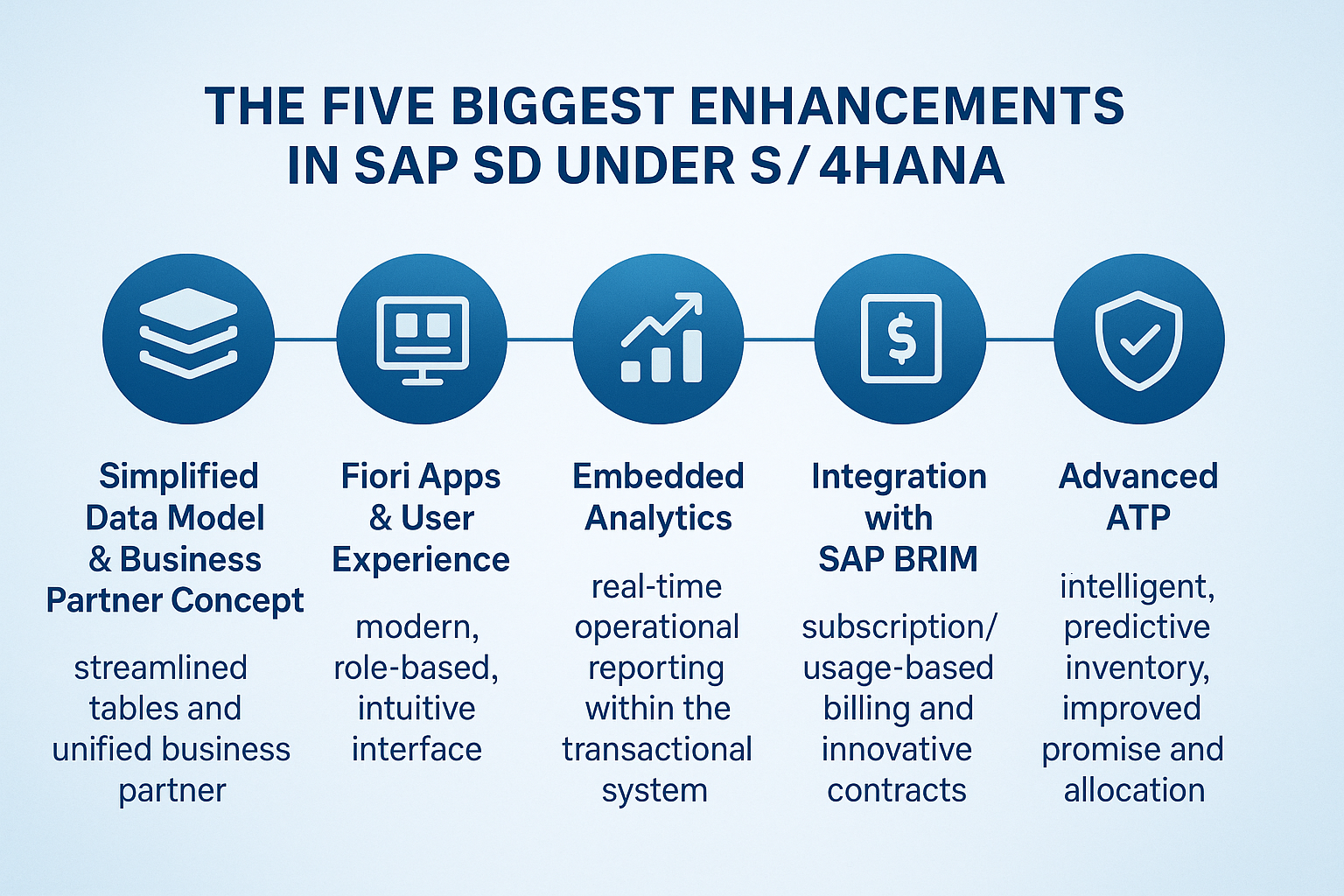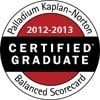For decades, SAP ECC was the engine that powered countless businesses. It was reliable and became the standard for many industries. But the way we conduct business has changed completely, and that old architecture struggles to keep pace with today's demands.
The Order-to-Cash (OTC) process is now at the center of a digital, real-time world. I've managed large-scale SAP projects across Aerospace, Logistics, Retail, and Manufacturing, seeing firsthand how older systems falter. Now, we have SAP SD S/4HANA, and it truly redefines how sales and distribution operate.
The changes are more than just a simple update; they represent a fundamental shift in capabilities. This is about preparing your business for what's next with a smarter, faster system. Explore how SAP BW Consulting can guide your journey.
The move from SAP SD in the old SAP ERP to SAP S/4HANA Sales was not just for a new name. It was a necessary evolution driven by the limits of old technology and the demands of modern commerce. Many of us felt the pain points of the previous system and understood that change was essential for growth.
Why Change Was Needed
If you worked with ECC, you know the struggles well. The system was filled with redundant data tables, leading to a bloated database that slowed everything down. Getting a simple report could feel like a major task because the system had to grind through so much information just to deliver basic insights.
Reconciliation between different SAP modules, like Finance and Sales, was a constant headache. I remember projects where innovation stalled because the sheer weight of ECC's complexity made any change a risky and expensive endeavor. Businesses needed agility, but the old sap process often delivered rigidity, hindering supply chain management.
What S/4HANA Brings to the Table
This is where SAP S/4HANA Sales changes the game. At its center is the HANA in-memory database. This technology lets the system process huge amounts of data in real time, turning reporting from a backward-looking chore into a live, forward-looking tool.
This is much more than a name change from the classic SD module to S/4HANA Sales. This new setup, the digital core of the latest sap business suite, is built for how business works today. It fully supports new business models like subscriptions, manages complex global trade scenarios, and handles omni-channel sales without issues.
It aligns sales functions with the speed of modern commerce, making order processing more efficient than ever. This evolution empowers companies to adapt and thrive.
The Five Biggest Enhancements in SAP SD Under S/4HANA
When you look at the architecture of SAP SD S/4HANA, you'll find some incredible improvements. These are not just minor tweaks. They are significant enhancements that streamline processes, improve user experience, and provide powerful new capabilities for any SD consultant and business user.
1. Simplified Data Model & Business Partner Concept
One of the biggest changes is how S/4HANA handles customer data. It eliminates dozens of old, redundant index and aggregate tables that made ECC slow and inefficient. For example, many old status tables are gone, with key sales document tables like VBAK (header) and VBAP (item) now streamlined, and everything ties neatly into the Universal Journal, ACDOCA.
A crucial element of this simplification is the mandatory adoption of the Business Partner model. In the past, you had separate objects for customers (customer master) and vendors, leading to duplicate data and reconciliation issues. Now, every sap customer and vendor is a Business Partner, a single, unified object that can hold multiple roles (customer, vendor, employee, etc.), centralizing all relevant customer business information.
This change significantly cleans up customer data and simplifies interactions across different business functions. The simplification means less data to store, which saves money. But more importantly, it makes the system lightning-fast, allowing you to get reports and analytics instantly.
| ECC SD Data Structure | SAP S/4HANA Sales Data Structure |
|---|---|
| VBUK (Header Status), VBUV (Incompletion Log) | Merged into VBAK (Sales Document Header) |
| VBUP (Item Status) | Merged into VBAP (Sales Document Item) |
| Separate index tables (e.g., VAKPA for partner index) | Replaced by Core Data Services (CDS) Views |
| Separate totals tables for revenue | Data now resides in the Universal Journal (ACDOCA) |
| Separate Customer and Vendor Masters | Unified Business Partner Model |
2. Fiori Apps & User Experience
Goodbye, old SAP GUI. Hello, SAP Fiori. The enhanced user experience in S/4HANA is a world apart from the classic, transaction-based screens of ECC. Fiori gives users a clean, modern, and role-based user interface that works on any device—desktop, tablet, or phone.
Specific Fiori apps like the Manage Sales Orders app or the Sales Order Fulfillment Cockpit are intuitive and simplify the process to create sales orders. An enhanced user can see everything they need on one screen, reducing clicks and improving efficiency. I've seen training times cut in half because the system is just easier to use and helps manage sales more effectively.
When sales reps can easily find what they need in a fiori app, they make fewer errors and can focus on selling. This directly improves the overall sap customer experience. The modern design of fiori apps helps boost adoption and productivity across the organization.
3. Embedded Analytics
In ECC, getting insights from your sales data often meant exporting it to another system like SAP BW. With SAP SD S/4HANA, analytics are built right into the system. Thanks to Core Data Services (CDS) Views, you get real-time operational reporting directly within the transactional environment.
Imagine a sales manager who doesn't need to run a separate report to see how they are doing. They just open their Fiori dashboard and see live KPIs like order fulfillment rates, sales volume, and open sales orders. For more advanced analytics, this data can also be connected to visualization tools like Power BI to create comprehensive dashboards for the entire enterprise.
They can spot problems instantly and take action before they impact the business. This real-time visibility is a massive advantage for any sales organization.
4. Integration with SAP BRIM (Billing & Revenue Innovation Management)
The economy is shifting to subscriptions and usage-based services. SAP BRIM is built for this world, and it integrates tightly with SAP S/4HANA Sales. It handles complex billing scenarios and sales contracts that traditional sap sd just was not built for.
In a recent postal sector project I worked on, we used this to implement dynamic billing based on shipment weight and destination. Before S/4HANA and BRIM, this would have required a massive amount of custom code. Now, it is a standard capability, letting businesses get more creative with their pricing and revenue models.
5. Advanced ATP (aATP)
Available-to-Promise (ATP) has been around for a while, but Advanced ATP in S/4HANA is a huge leap forward. It is smarter, more flexible, and more powerful than its predecessor. Advanced ATP gives you more sophisticated ways to handle product allocation and manage backorders.
For example, aATP can predict inventory availability with greater accuracy and help you make better promises to your customers. It allows for more complex confirmation strategies, including:
- Product Allocation (PAL): Ensure fair share distribution and prioritize key customers during supply shortages.
- Backorder Processing (BOP): Intelligently re-distribute supply for existing sales orders based on new priorities or incoming stock.
- Alternative-Based Confirmation (ABC): Automatically propose alternative locations or products if the initial request cannot be fulfilled.
This means fewer stockouts, improved on-time delivery rates, and ultimately, higher customer satisfaction. It lets you strategically prioritize your most important business partners when inventory is tight.
Architectural Shifts — The New S/4HANA SD Framework
The improvements in S/4HANA Sales are not just at the surface. They are backed by major architectural changes that make the whole system more efficient, integrated, and powerful.
Universal Journal (ACDOCA)
The Universal Journal is perhaps the most important innovation in S/4HANA. It brings together financial accounting (FI) and controlling (CO) data into a single table: ACDOCA. This single source of truth eliminates the reconciliation problems that plagued ECC systems for years.
In old projects, posting revenue across multiple company codes often required complex manual workarounds and adjustments at the end of the month. With ACDOCA, sales transactions post directly to the journal, and the financial view is always perfectly aligned with sales and distribution. This saves the finance team an incredible amount of time and effort.
Credit Management and Output Control
S/4HANA also modernizes how you handle credit checks and customer communications. Credit management moves from the old SD module to SAP Financial Supply Chain Management (FSCM). This gives you much more sophisticated tools for managing credit risk, like automatic credit scoring and a central view of customer exposure across the entire sap business.
Output management has also been updated. It now uses the Business Rules Framework plus (BRF+), a powerful rules framework for defining how documents like order confirmations and invoices are generated and sent. This gives you more flexibility to define complex business rules for communication, supporting modern electronic formats easily and reducing the need for custom coding.
Data Volume Reduction and Real-Time Reporting
By getting rid of dozens of aggregate and index tables, S/4HANA dramatically reduces the amount of data your system has to store. According to SAP, this can reduce your data footprint by a factor of 10 or more. A smaller database is faster and costs less to run, lowering your total cost of ownership (TCO).
This streamlined data model is what allows S/4HANA to give you real-time reports. Because there is no need to aggregate data on the fly, your analytics are always live and up to date.
The Fiori Advantage — Designed for the Modern Sales User
You cannot talk about SAP SD S/4HANA without discussing the user experience. The shift to Fiori is about more than just a pretty interface. It is about making people more productive and engaged with their work.
From SAP GUI to Fiori Experience
The difference between the old SAP GUI and the new Fiori launchpad is night and day. SAP GUI was a wall of transaction codes (like the classic transactions xd series) and complex screens. Fiori offers a clean, tile-based dashboard that is customized for each user's role.
Navigation is intuitive. Analytics are embedded right into the screens, giving users immediate context for their tasks. And because it is built on modern web standards, it works flawlessly on a phone or tablet, freeing your sales team from their desks.
Boosting Adoption and Productivity
In my experience, user adoption drives the success of any transformation. When sales teams actually enjoy using the system, data accuracy for sales orders and sales velocity increase. They spend less time fighting with the system and more time talking to customers and helping them create sales.
This improved usability directly impacts order processing times and accuracy. Happy users mean a better return on your technology investment. It is that simple.
SAP BRIM — Powering the Subscription Economy
The world is moving away from one-time product sales and towards recurring revenue streams. From software to industrial equipment, businesses are selling services and subscriptions. SAP BRIM is the engine for this new economy.
Why BRIM Matters
Traditional billing systems are built for shipping a box and sending an invoice. They struggle with usage-based billing, tiered subscriptions, and revenue sharing. SAP BRIM is designed to handle this complexity with ease, and its integration with S/4HANA SD makes the entire process seamless.
It allows you to bill for almost anything dynamically. This is critical for staying competitive in a world where customers expect flexible, consumption-based options. It enables new business models and revenue streams.
Industry Examples
You can see the power of this combination in many industries. A logistics company can bill for freight based on real-time distance and weight data from its supply chain operations. A telecom or postal service can offer complex subscription tiers with different usage allowances, managed through integrated sales contracts.
For Professional Services, you can bill clients automatically as project milestones are met or based on hours consumed. The data from SAP BRIM also flows into S/4HANA analytics, which is a huge win for forecasting. My SAP BW expertise shows how you can accurately predict recurring revenue and model the impact of new pricing strategies.
Migrating from ECC to S/4HANA SD — What to Know
Moving to SAP SD S/4HANA is a major sap project, not a simple upgrade. Planning your migration carefully is critical to success, and there are key factors to consider when implementing sap s/4hana.
Migration Path Options
You generally have three ways to get to S/4HANA. The right choice depends on your business needs, budget, and how much you want to change your existing sap process.
- Greenfield: A completely new implementation. This is your chance to redesign your processes from the ground up and adopt best practices.
- Brownfield: A system conversion that brings your existing configuration and data over to the new platform, minimizing disruption.
- Selective Data Transition: A hybrid approach where you move some processes and data while redesigning others, offering a balance of both worlds.
Data Preparation Essentials
You cannot move messy data into a clean new system. Before you migrate, you must get your house in order. A crucial pre-migration step is the Customer Vendor Integration (CVI) process, which converts all customer and vendor masters into the new Business Partner model.
This means cleansing your existing customer and material master data, archiving old documents, and reviewing all your pricing conditions and partner functions. A clean start prevents problems down the road and ensures a smoother transition. This preparation phase is one of the most important parts of the entire implementation sap project.
Integration Readiness
Remember, the sd module does not live in a silo. It is tightly connected to other sap modules like Materials Management (MM), Finance (FICO), and Production Planning (PP). Integration with Warehouse Management, especially EWM SAP, is also critical for seamless order fulfillment and supply chain visibility.
Even connections to Human Capital Management systems like HCM SAP or SAP SuccessFactors might be relevant for sales commissions and performance tracking. A successful migration requires a coordinated plan that considers all these dependencies. A value-stream map of the OTC process is essential to understand how work flows through your business before you can improve it.
The Business Case — Why It Matters
A move to S/4HANA is not just an IT project. It is a business transformation project with real, measurable benefits that affect the entire organization, from sales to human capital.
Quantified Benefits of S/4HANA Sales
The results speak for themselves. Companies moving to SAP S/4HANA Sales often see amazing improvements in their operations. These benefits stem from increased process automation and real-time insights.
- Up to 40% faster order-to-invoice cycles.
- A 25% reduction in master data errors due to the simplified Business Partner model.
- Real-time visibility into order profitability.
- Streamlined and automated credit and billing workflows.
- Improved site operation efficiency across global locations.
Strategic Impact
These numbers translate into strategic advantages. Improved agility helps you respond to market changes faster. Better reporting gives you the insights to make smarter decisions about things like inventory turns and on-time delivery.
Modernizing your core systems is also about future-readiness. It opens the door to cloud adoption and using advanced technologies like AI in your sales processes. It's a move that secures your competitive edge for the future, and proper learning journeys for staff will help maximize its value.
Ready to move from ECC to S/4HANA SD? Learn how our experts can guide your transition.
Conclusion — The Future of Order-to-Cash Is S/4HANA
The shift from SAP ECC to SAP SD S/4HANA is a reinvention of the entire Order-to-Cash process. We have moved from a slower, rigid system to a smart, agile, and data-driven platform. This is the path forward for any business that wants to optimize its sales operations and stay competitive.
With its simplified data model, intuitive Fiori experience, and powerful embedded analytics, S/4HANA Sales is built for the demands of the modern digital economy. As a global SAP Project Manager, I've seen these transformations up close across different industries, and the benefits are clear and consistent.
Talk to SAP BW Consulting about planning your SAP S/4HANA Sales roadmap.
Need Expert SAP Consulting Expertise?
We are team of top-level SAP consultants, focused on helping you get the most value from your SAP investment. Whether you need a single SAP SD consultant or an entire team of SAP experts, we can provide them. Please our book a meeting service to get started.





